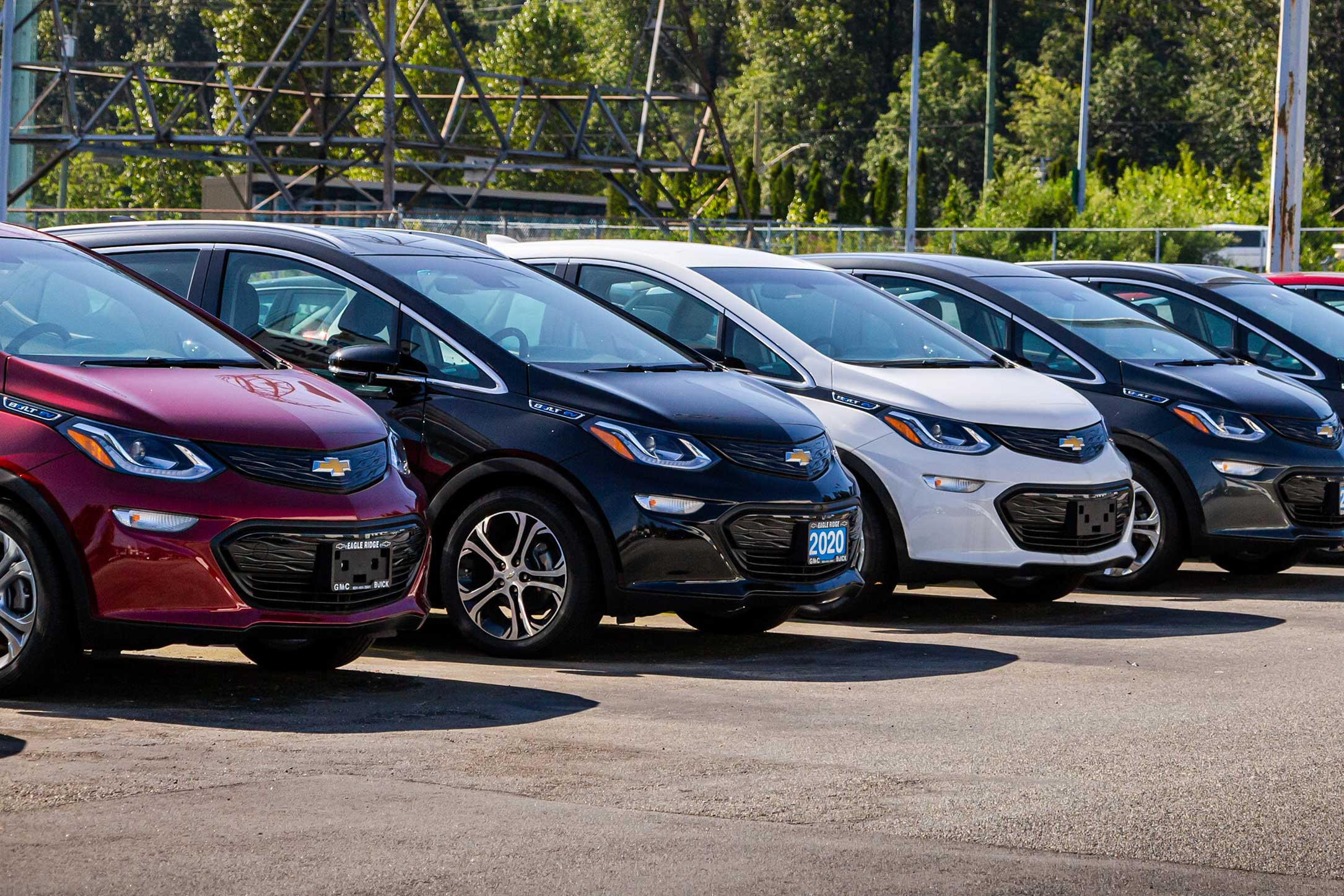Hey world-savers, and welcome back to one5c. I’ve had transit on the brain of late, mainly because the new high-speed rail line connecting Orlando to Miami and Amtrak’s $10 billion upgrades have got me hyped. The U.S. needs more (and better) transit. Full stop. But for now most of us still rely on cars, and if we’re gonna have ‘em, electric is the way to be. Around this time of year, the Mad Men will try their darndest to convince you that a new ride with a big red bow would look excellent in your driveway. Before you take them up on it, we’re taking a looksee at what changes to EV rebates could save you.
If you’re always down for a good deal, definitely forward this email to someone who also likes saving money—and the planet. —Corinne
how to get the most out of federal ev rebates
By Tim Stevens

Looking’s better than buying these Chevy Bolts until next year. CineCam/Shutterstock
If you bought a new EV in 2022, you got a pretty great deal. The federal rebate rules then were about as straightforward as you can get: If the car had a battery bigger than 10 kilowatt-hours (which is basically all of them), you could deduct $7,500 on your taxes. Easy.
As part of its efforts to bolster domestic production, the Inflation Reduction Act added guardrails around what you buy, where it’s built, and how much you can earn to qualify for the cash. The legislation was a boon in U.S. electric car manufacturing, but the updated rules caused a lot of confusion at dealerships.
This year, things are changing once more—and for the better. While the qualification checklist largely stays the same, getting a $7,500 payout when buying a new EV has become almost instantaneous. Here’s a rundown of what you can get, and how you can get it.
The qualification checklist
To get the full $7,500 back on a new vehicle (or up to $4,000 for a used one), you must satisfy certain criteria. First is your income: To be eligible, you have to earn less than $150,000 as an individual, $225,000 as a head of household, or $300,000 for couples filing jointly.
Second is the cost of the vehicle: If you’re buying an electric truck, van, or SUV, it’s gotta cost less than $80,000 (for context, a Ford F-150 Lightning starts at about $50,000). Anything else—like a Tesla Model 3 or Volkswagen ID.4—must sticker below $55,000. (For used cars the cap is $25,000.)
The final two checkboxes are about the makeup (and making) of the car itself. The vehicle must have been assembled in North America by a “qualified manufacturer“—basically, a major automaker registered with the U.S. government, like Ford or Tesla. Finally comes the sourcing of materials for the car’s battery pack. This one is a bit nuanced; all the IRS says is that the batteries must meet “critical mineral and battery component requirements.” You can read that as government-speak for “no power packs from China.” If your vehicle of choice is assembled outside of North America or its battery is verboten, the $7,500 figure drops to $3,250. If it’s a foreign-assembled car with a foreign-sourced battery, you get zilch.
It’s a lot to keep track of, so definitely check the list of federal eligible vehicles as part of your browsing process.
What’s changed in 2024
Historically, the federal EV rebate has been just that: a rebate subtracted from your tax bill. That meant, at best, you wouldn’t see that $7,500 until you filed with Uncle Sam the following April. It also meant that if you didn’t owe any taxes, you’d get nothing.
In 2024, the federal EV incentive is immediately available at the point of sale. It’ll simply get subtracted from the price of the vehicle, or the dealer can offer a cash equivalent. A lower price means reduced monthly payments if you’re financing, or a smaller check to write if you’re in the lump-sum crowd.
The actual amounts refunded won’t change. However, the question of tax burden has gone away. So, let’s say you owe $3,500 on your 2023 taxes (which you’ll file in 2024) and bought a car eligible for the $7,500 rebate in the fall of 2023, your savings cap at $3,500.
Pick out that new ride today, and you’ll save the full $7,500—and you’ll get it immediately. Killer deal, right? Our final advice: Don’t let the cash influx from the rebate make you get lax with your haggling skills.
The roundup
In the news this week
- A ballot measure to shift ownership of Maine’s electric utilities to residents failed, which is a shame: Look what taking ownership away from private entities has done to help Kauai build a cleaner and cheaper grid.
- The World Health Organization’s lead doctor for environmental health has grim a message for climate-denying politicians like Louisiana’s newly elected governor: “You have to live with that weight on your shoulders.”
- A new report shows that the meat and dairy industry is going the wrong way: Emissions from the world’s 20 largest companies are up 3.3% from 2022 levels. Consider this your semi-regular reminder that eating less meat is one of the easiest ways to help address the climate crisis.
- Inside Climate News reports on how an Illinois community derailed one of the country’s biggest CO2 pipeline projects. The conduits that move captured carbon between production facilities and storage can be dangerous business for the communities they pass through.
- The Biden administration is touting progress in 15 clean-energy projects, including solar and geothermal initiatives, after recent setbacks for offshore wind. The White House says we’re on track to reach 2025 goals, though it’s still too soon to tell how that’ll pan out.
